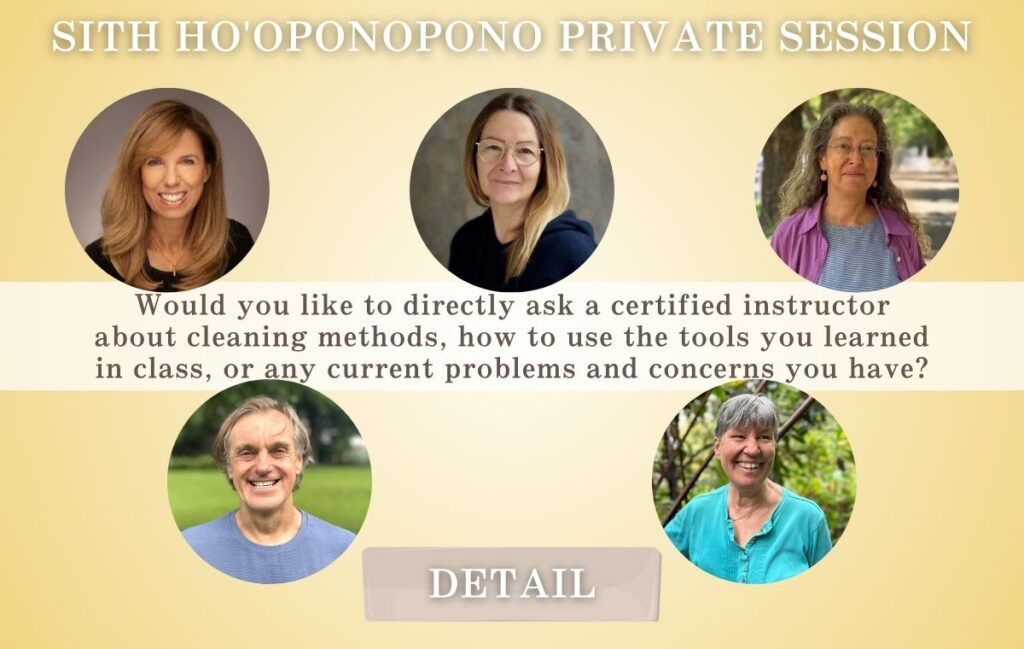This is an interview article with Nello.
Nello’s responses are highlighted in light blue.
Cleaning Is a Path to Inner Peace and Harmony
Today’s question is about how to clean with expectations for results.
Cleaning is a subconscious process. Deep-rooted memories don’t always cause immediate changes on the outside with just one cleaning.
But modern people tend to lack patience and often expect to see results right away when they clean.
Nello, what are your thoughts on this? How can we continue cleaning with more patience?
Cleaning itself is the “result.”
For me, cleaning is not like a hammer. In other words, it’s not a tool used to strike hard in order to get the result we want.
What we call “results” in Ho’oponopono are not visible events that our minds imagine.
Ho’oponopono first guides us back to “inner peace and harmony.”
For example, when I’m in a conflict with someone, I don’t clean to win the argument—I clean to return to my own peace and harmony.
If you look at the cleaning tools shared in class, many of them are very simple to use.
Some involve food, others use flowers or colors. These simple tools show that we can also return to peace and the “zero state” in simple ways.
Ho’oponopono is the path that leads us to “zero.”
This “zero” is a state where we do not fixate on any specific outcome.
If we decide, “I want things to turn out this way,” then we move away from the true purpose of Ho’oponopono.
When we return to zero through the practice of Ho’oponopono, we return to a state of openness.
That is the “result” Ho’oponopono offers us.
Ho’oponopono brings us back into the flow.
There, even if things don’t unfold as we imagined, we begin to feel that life is getting better.
For example, when practicing the “12 Step Process” (the core content of SITH Ho’oponopono, taught in class), you might feel, “This is boring.”
But that feeling comes from expecting “some kind of result” after doing the 12 Step Process.
For me, I practice the 12 Step Process because I want to reconnect with myself.
Whether it’s for 20 minutes, 30 minutes, or an hour—that time is something I want to give to myself.
Especially when facing problems or challenges, connecting with my inner self becomes even more important.
The path of Ho’oponopono is a path to reconnect with oneself.

The Outer Reality Is Created by Inner Memories
As I mentioned earlier, let me say it again.
The way Ho’oponopono transforms our lives is through “changing the inner world, which then changes the outer world.”
Think of it like this: our outer reality is like a building made by stacking bricks one by one.
In Ho’oponopono, these bricks are considered “memories.”
We’ve built our current outer reality by stacking these memory bricks.
So, if we want to change our outer experiences, we need to change the “bricks” — the memories.
When the inner world changes, the outer reality also regains its fluidity.
If our inner world is peaceful, harmonious, and abundant, the outer world becomes that way too.
On the other hand, if our inner state is filled with thoughts like “I’m poor, I lack things, I don’t have money,” then our outer experience will also reflect poverty and lack.
Ho’oponopono is a “path to knowing oneself.”
It means looking at what kind of memory bricks are creating our outer reality.
It’s not about changing the outside; it’s about working from within.
Nello’s Daily Cleaning
Thank you. Lastly, could you share how you clean in your daily life? Are there any tools you use often?
When I wake up in the morning, I begin with “Care of Unihipili.”
During the day, I often drink Blue Solar Water. In fact, I had some right before this interview.
I also use the cleaning tools I’ve learned in class on a daily basis.
After interviews, I often go for a walk in nature and say “Ice Blue” while touching trees and flowers.
Recently, there have been beautiful violets blooming near where I live. I touch them while saying “Ice Blue”—it’s become part of my daily routine.
When I go to the market, I sometimes buy food or drink items that serve as cleaning tools.
My fridge often has blueberries or strawberries.
I also buy healthy foods that I feel inspired by at the market. I often enjoy hot chocolate too.
These “eating” and “drinking” cleaning tools can be naturally integrated into daily life, so there’s no need to set aside special time for them.
Another tool I use frequently is “I LOVE YOU.”
Lately, I’ve been cleaning memories related to human relationships, and when I feel emotions like hatred, I say “I love you.”
This helps stop the negative thoughts that play within me.
I also use a smartphone daily—for work and in private life—and I clean by saying “Thank you” at the start and end of interactions.
Thank you very much.
I also love going into nature and using simple cleaning tools like blueberries and strawberries.
I look forward to speaking with you again.




